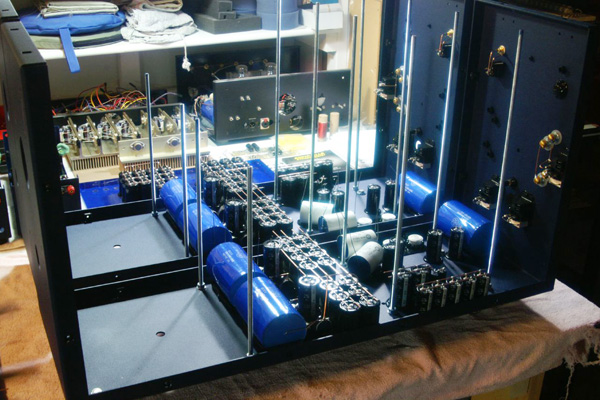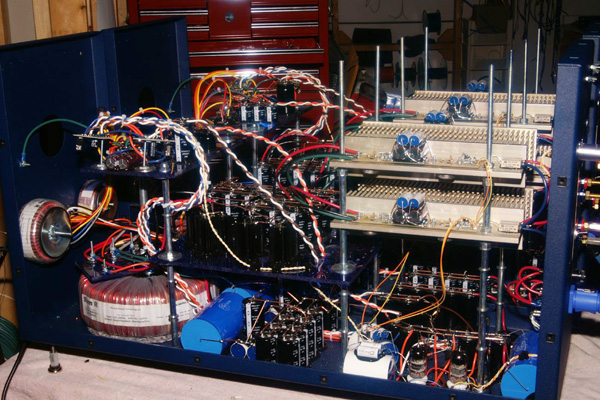 |
||
| August 15, 2008 Searching for the Extreme: Gilbert Yeung of Blue Circle Audio -- Part Two Last month, I began my discussion with Gilbert Yeung of Blue Circle Audio. We covered topics that ranged from the importance of power supplies in his product designs to a new batch of amplifiers and preamplifiers based on his Pinkie Project prototype of a capacitor-powered preamp. This month, we wrap up by talking about a few other design elements that make Blue Circle products unique. Gazing into the interiors of a number of different BCA products reveals the conspicuous absence of one common component: the circuit board. I asked Yeung to explain why he doesn’t use circuit boards, and why he feels point-to-point wiring is superior. "From the very beginning, almost every designer is a do-it-yourselfer, and I was no different. Most DIYers stay away from PCBs simply because of the high cost of setup. With point-to-point wiring, making one or two pieces is cheaper and easier, as long as the circuit is not very complicated and does not involve high-speed digital. "As BCA evolved into professionally selling products in the marketplace, low-quantity production with high-quality results was still the case. The very first commercially available Blue Circle product was the BC3 Despina preamp, which was wired point to point. With a simple, straightforward design such as the BC3, point-to-point wiring has an additional benefit: There is no stray (unpredictable) capacitance in the circuit. The actual circuit and signal runs three-dimensionally inside the chassis. This also made the signal path shorter, because it can usually run as a straight line from A to B. With a PCB, it has to be routed around a lot of components that are in the way. "As time went on, more complicated circuits evolved: low-level signals such as those in phono stages, and high-speed digital circuits such as DACs, demanded that I use PCBs. Even then, we still use point-to-point wiring in the power-supply sections of our phono stages and DACs. Most of our higher-end preamps still have point-to-point wiring in all audio signal paths."
With all Yeung’s talk last month about the importance of power supplies, I wondered how important the actual circuit is in comparison. "The actual audio circuit is as important as the power supply," Yeung said. "However, I like to keep things simple. There are a lot of overdesigned, overengineered products that have way too many parts and unnecessary circuit complexity. The more complex they are, the more chance for something to go wrong. A gain stage of an audio amplifier needs only one tube stage, or even one op-amp stage. Yes, you heard that right: op-amp. Op-amps are so good these days. There is no point to designing a discrete circuit unless it is at the output stage of a power amp -- which requires high power handling -- or a designer wants to show off what they can do." Yeung is not a big believer in audiophile parts; e.g., capacitors, wiring, transformers, etc., made by companies whose names most audiophiles would recognize. So how does he choose parts for BCA products? "Most audiophile parts are simply a ripoff. They look very, very good, and are fancy on the outside, but don’t open it or you’ll be very disappointed. Most of them gain a name in the audiophile consciousness by marketing and networking, not necessarily by quality. As soon as they get a name, they patch that name onto some mediocre part and call it ‘audiophile grade.’ In some cases, the only difference between the audiophile part and a regular industrial-grade part is the name and the cost. Audiophile-grade parts cost a lot more than industrial grade for the same part. "In the early days, as I was designing components, I often bought several brands of parts, audiophile and non-audiophile. I tested the parts by hooking them up for a listen. As time went by, I began to be able to judge these parts by their specs -- up to a point. After many years at this, I can now tell whether a part is suitable principally by its specs, and my success rate is about 90%. When I get down to a couple or three choices of the same part, I will try to get samples and test them in house, but most of them usually end up as industrial- and military-grade parts. I do sometimes get audiophile-grade parts, just to make sure I’m still right about them. So far, I’ve been right every time. I hope this will change, but it doesn’t seem to be the case, at least for the near future. "When I pick parts, they have to be technically and sonically correct. Sometimes our ears tell us what sounds good, but they don’t measure well. I go back to the drawing board and try to figure out why. So far, 100% of the time, we end up using parts that sound good and measure well. If it only sounds good but measures not so well, it is usually because something was done wrong in the design process to make that part sound better than the others. I also don’t allow salespeople to come in here to try to sell anything to us. I don’t want any interference by marketing. Everything we use has to have a good sonic and technical reason before we use it."
Blue Circle Audio has been manufacturing audio gear since the early 1990s, and now has 16 years’ worth of products in the field. Curious to find out exactly what has changed in Yeung’s designs in that time, I asked him to describe the biggest differences between the earliest and the most recent BCA products. "There are two early products to consider: the BC3 preamp and the BC2 power amp. The BC3 was made available to the market in 1992, and the BC2 about three years later. When I designed the BC3, I designed it for my own purposes. I wanted to have a preamp that sounded good, and at the same time was neutral enough for me to hear what was going on at the front end. It also had to be capable of driving long distances -- up to 500’. To this day, those objectives are still my goals. "The BC2 was more of a market-driven product. Single-ended class-A design was in fashion. I thought that, in order to go to the Consumer Electronics Show and make a name for myself, I needed to have something unique and, at the same time, fashionable. As a single-ended hybrid amp with a tube at the front end and bipolar solid-state at the output, the BC2 was unique and fashionable enough for that purpose -- in fact, I believe we were the only ones who did that exact design. It worked. The BC2 even won the SoundStage! Network Hall of Fame award, which I kept telling Doug Schneider was a mistake. The award should have been given to the BC3, because after 16 years, the BC3 is still available and still selling. "During those early times we used some audiophile-name branded parts to attract buyers. As we gained a reputation and people started to accept our way of doing things, I started doing research into more things, including our own branded parts. Eventually, my design approach turned into reality. The 200-series amplifiers are the best examples of my view of what an amplifier should be." That concludes my conversation with Gilbert Yeung. His BC108 power amp will arrive at my Music Vault in only a few months. Stay tuned for details about this latest chapter in the history of Blue Circle Audio. . . . Jeff Fritz
Ultra Audio is part of the SoundStage! Network. |

